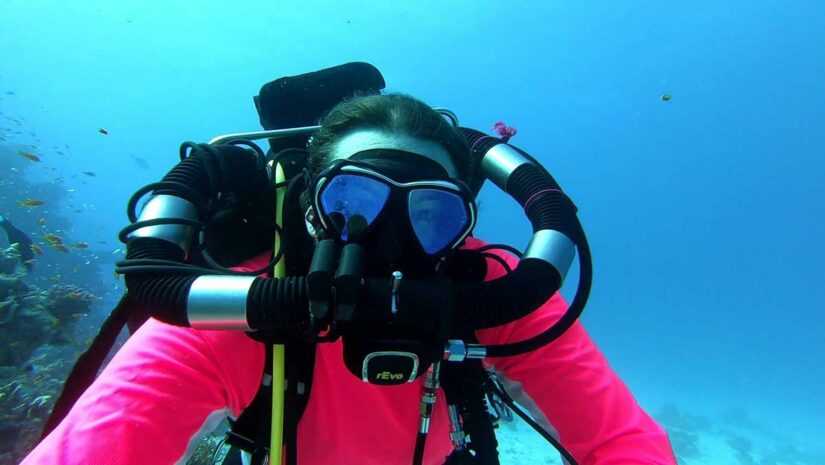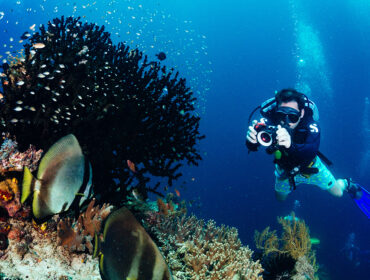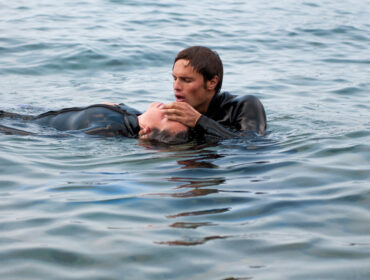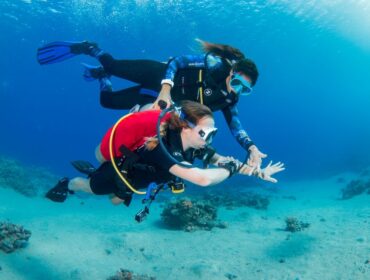Have you ever heard of rebreather diving or been intrigued by it? Welcome to a peek into this fascinating part of diving. While scuba diving is a beautiful experience on its own, rebreather diving brings to it a whole new level of adventure. In this article, we will go over the fundamentals of rebreather diving, how it works and highlight its various benefits. But that’s not all; we’ll also tell you about some of the most beautiful places in the world where rebreather diving is popular.
What is Rebreather Diving?
When you dive, you need air to breathe. Regular scuba tanks carry air you breathe in, and bubbles come out every time you exhale. Rebreather diving is different. Instead of letting bubbles out, rebreathers recycle the air you exhale. It’s like having a mini recycling machine for air on your back while diving! This means fewer bubbles and you can stay underwater for longer and even deeper. There’s really nothing that compares to it. Rebreather diving is the closest thing to becoming a fish.
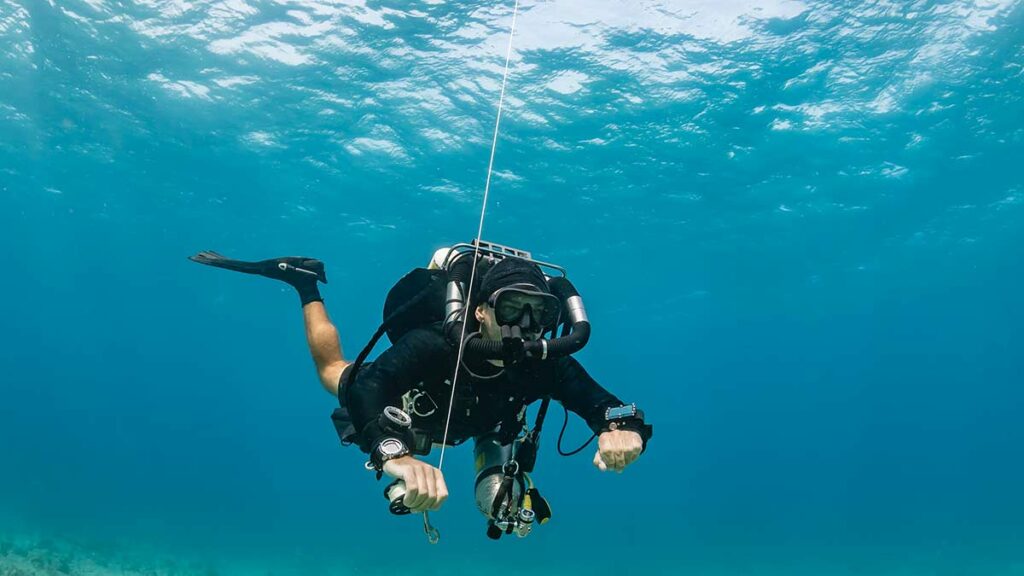
Understanding Rebreather Technology
Imagine if every time you breathed out, instead of wasting the air from that breath, you could reuse it. That’s the magic behind rebreathers! When you exhale, your breath has carbon dioxide in it, which isn’t good to breathe back in. A rebreather cleverly removes the bad carbon dioxide from your exhaled breath, and gives you back oxygen in exchange. It’s like an air-recycling machine!
There are two types of rebreathers:
- Closed-circuit rebreathers (CCRs): These are the ultimate recyclers! They recycle almost all the air you breathe out, only letting out tiny bubbles every now and then. This makes them super stealthy underwater.
- Semi-closed rebreathers (SCRs): These produce a bit more bubbles. They recycle some of your air but also mix in fresh air from a tank. So, you’ll see more bubbles, but not as many as traditional scuba gear.
Parts of a Rebreather
For a rebreather to work properly, there are a few key components to make them work.
Scrubber & Canister
A scrubber is the hero that captures and removes the carbon dioxide from your exhaled air. It’s like a sponge but for bad air. The canister is where the scrubber material is placed, and it’s where the carbon dioxide is removed from the exhaled gas.
Counter-Lungs
Think of these as your underwater “breathing bags”. They store the air you breathe out and the refreshed air you’ll breathe in next.
Oxygen Sensors
Oxygen sensors are the gadget’s “noses”. They keep track of how much oxygen is in the mix, making sure it’s safe for you to breathe.
Oxygen Tank
An oxygen tank contains pure oxygen and is the primary source of the oxygen you breathe during a rebreather dive.
Diluent Tank
The diluent provides a mix of gases (often a mix similar to regular air or a specialized blend) that is used to “dilute” the pure oxygen being added from the oxygen tank, ensuring the resultant breathable mix is safe and appropriate for the current depth.
Dive Computer
It’s an essential piece of equipment for rebreathers. A dive computer monitors the gas mixtures, depth, and other critical parameters. It can alert divers if the gas mixture becomes unsafe or if other issues arise.
Mouthpiece or DSV (Dive Surface Valve)
The diver breathes from this, and it usually has a switch to allow the diver to shift from breathing from the rebreather loop to breathing ambient air at the surface.
Gas Addition Valves
These valves introduce fresh gases (like oxygen) or a diluent (like air or trimix) into the breathing loop to maintain the correct and safe gas mix.
Overpressure Valves
They release gas from the counter-lungs if the pressure gets too high, ensuring that the loop doesn’t over-inflate.
Rebreather diving offers a more intimate, extended, and efficient dive experience, unlocking possibilities traditional scuba can’t achieve.
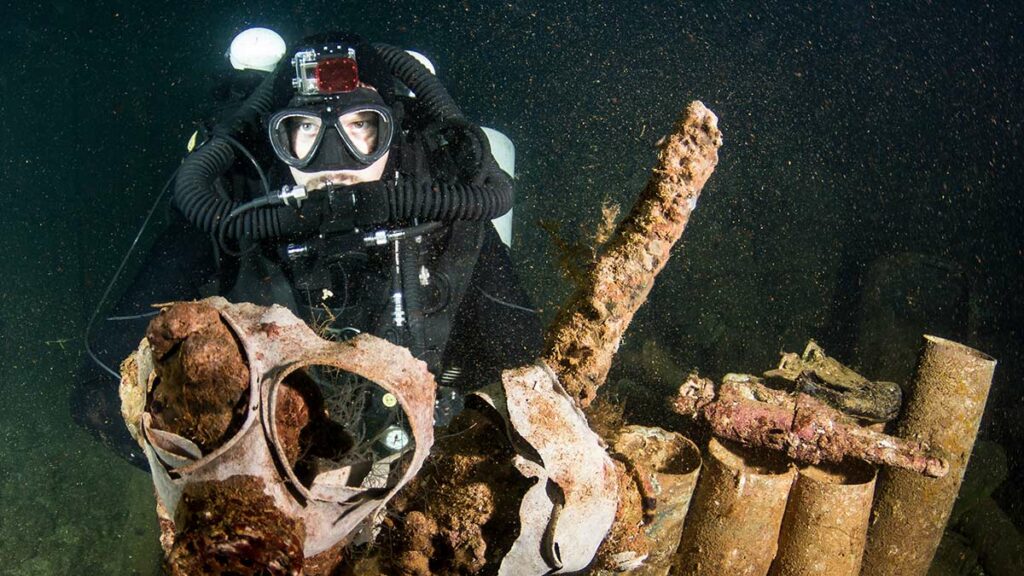
Advantages of Rebreather Diving
There are many advantages of rebreather diving. Here we sum up the most important ones.
Longer Dive Times
Rebreathers efficiently recycle air, meaning divers can stay underwater for extended periods compared to traditional scuba systems.
No Bubbles
Unlike open-circuit scuba, rebreathers release minimal bubbles. This makes observing marine life more natural, as creatures aren’t scared away. Underwater photographers especially love this advantage as it allows them to get really close to their subjects.
Silent Diving
Without the noise of bubbles, divers experience a quieter underwater environment, again ideal for photographers and those that are interested in aquatic life.
Extended Range
Especially for technical divers, rebreathers can allow for deeper dives and longer bottom times due to efficient gas usage. For deeper dives, helium is added into the diluent mix ensuring a safe and breathable mix. The tanks needed for a deep dive are not as many with a rebreather as needed for an open circuit system, allowing the diver greater mobility.
Reduced Decompression
The consistent delivery of optimal gas mixtures can decrease decompression times in certain diving situations.
Gas Efficiency
As the oxygen in the system is re-circulated in the loop, a diver may utilize up to 99% of the oxygen in the system as opposed to an open circuit system where 20% of the Oxygen is absorbed by the Divers lungs. This creates gas efficiency, with a tank the size of a regular air tank of oxygen lasting ages longer before needing to be changed, limited only by the scrubber.
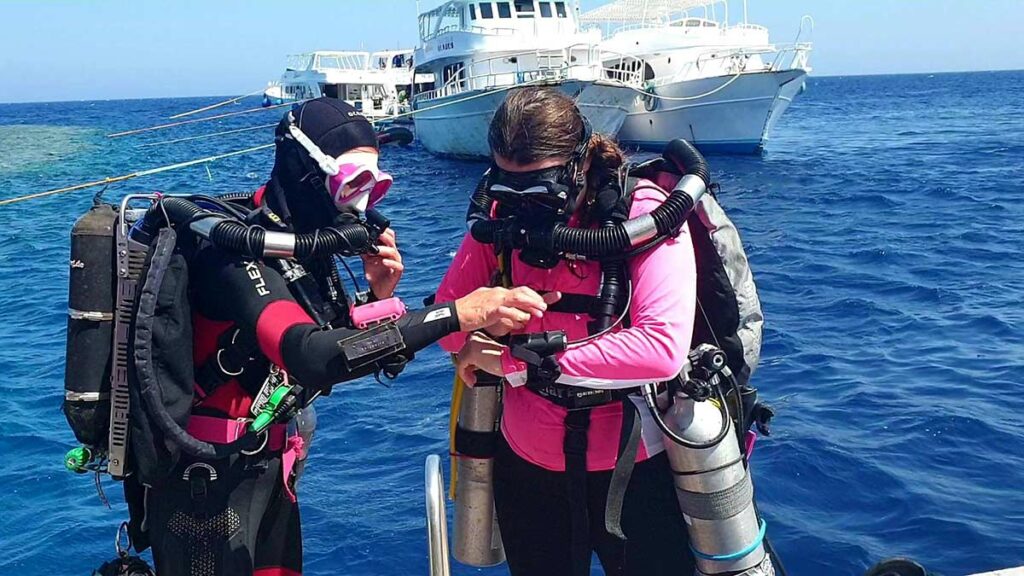
Essential Training and Certification
Rebreather diving isn’t just regular diving with a fancy gadget on your back. It’s a whole different game. The equipment is more complex, and there’s a lot more you need to keep track of when you’re underwater. Without the right training, it’s not just about having a ruined dive; it can be seriously dangerous. Think of it as needing a special license to drive a race car instead of just any car. That’s why having a certification from a recognized agency is a must before attempting rebreather diving.
Before even thinking about rebreather courses, you must be an experienced diver. Typically, you’ll need an advanced open-water certification and a certain number of logged dives. This ensures you’re already comfortable in the water and understand basic dive principles.
Then, there are specific skills and knowledge areas you’ll learn in a rebreather course:
- How the rebreather machine works, from the technical bits to the breathing parts.
- What to do if something goes wrong (if a warning beeps or you feel something’s off).
- How to plan a rebreather dive, making sure you have enough supplies and checking everything twice.
Leading dive agencies have specialized courses to guide divers into the world of rebreathers. PADI runs the “Rebreather Diver” course and further deepens skills with the “Advanced Rebreather Diver.” Meanwhile, TDI focusses on technical diving, offering “Air Diluent CCR Diver” for beginners and the “Mixed Gas CCR Diver” for those seeking deeper adventures. Additionally, IANTD caters to both recreational and technical divers, with its “Recreational Rebreather Diver” and “Technical Rebreather Diver” programs.
Rebreather Diving Safety Considerations
Rebreather diving takes underwater exploration to a new level, offering longer, deeper, and quieter dives. However, with these advantages come certain risks that divers need to be aware of.
The most significant concerns in rebreather diving are equipment malfunctions and oxygen toxicity. If the rebreather fails in its essential task of removing carbon dioxide or supplying oxygen, the consequences can be severe. In addition, while oxygen is our life source, in excessive amounts and under the pressures of deep diving, it can turn toxic.
Rebreather diving safety demands meticulous planning. Divers must thoroughly inspect each component of their rebreather system before heading into the depths. Every component, from the carbon dioxide scrubber to the important oxygen sensors, must be in perfect working order.
Redundancy, or having a backup plan, is equally critical. Just as we might carry an umbrella even on a clear day, divers should have bailout tanks or an alternate air source. These backups act as safety nets, ensuring divers can handle unexpected situations.
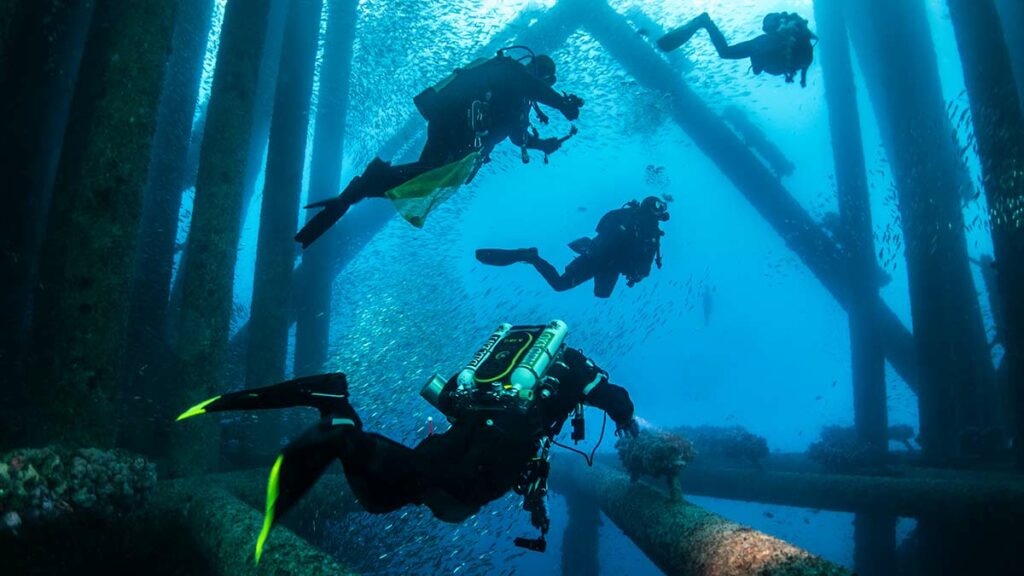
Rebreather Diving Destinations
Technically, you can dive almost anywhere with a rebreather, but there’s a catch. You either must carry with you all of your equipment and components, such as scrubbers, or rely on a dive center/shop that supports rebreather diving. Keep in mind that not every diving shop is specialized in this so more often than not you’ll most likely have to bring even your own scrubber. And if they aren’t a technical dive facility, chances are you’ll have to stay to recreational restrictions when diving with them.
With that said, there are several special places across the world that don’t just tolerate rebreather divers; they cater to them, offering the technical assistance and expertise that such diving requires. Let’s look at some of these places:
Dahab, Red Sea, Egypt
Nestled in the breathtaking Sinai Peninsula, Dahab is every diver’s dream. Not only does the iconic Blue Hole promise deep dives and beautiful underwater formations, but the vibrant marine life, ranging from multicolored fishes to soft corals, makes it a spectacle. The warm waters and the stunning Jackson Reef are other highlights, promising a dive that is both challenging for the pros and welcoming for the beginners.
Truk Lagoon, Micronesia
Imagine diving among history at one of the best shipwreck dives. The Truk Lagoon is a watery grave for sunken warships and fighter planes from World War II. Each dive promises stories whispered through rusted metal and coral-encrusted artifacts. And with a rebreather, divers can get closer, exploring the eerie depths without disturbing the resting relics.
Malta & Gozo
These islands are famous for their beautiful wreck sites, but they also have a rich history and natural formations (caves and tunnels!) that await exploration. Divers equipped with a rebreather can enjoy extended bottom times, providing a more complete and thorough experience of sunken treasures such as the famous MV Karwela wreck. Diving with a rebreather in Malta and Gozo is nothing short of spectacular.
Cayman Islands
Think of dramatic underwater walls and thriving marine ecosystems, and the Cayman Islands will come to mind. Particularly impressive is the Bloody Bay Wall in Little Cayman, where the marine life is vibrant, and the wall’s drop-offs are awe-inspiring.
Philippines
The Philippines is an amazing chain of islands, full of fantastic dive sites. While the Tubbataha Reefs offer pristine coral atolls, the Apo Island promises encounters with large sea turtles. And then there’s Coron, where historic sunken Japanese warships await exploration.
Bonaire
Bonaire is a diver’s paradise. With over 60 shore dive sites, you will never run out of new sites to explorer. The Hilma Hooker shipwreck and the Salt Pier are must-visits. The island’s dedication to marine conservation ensures encounters with healthy corals and diverse marine species. Several dive shops on the island cater to rebreather divers.
Roatan, Honduras
Roatan, part of the Bay Islands, is close to the Mesoamerican Barrier Reef. Shark dives at Cara a Cara and Spooky Channel’s labyrinth guarantee adventures that rebreather divers will never forget.
Tulum, Mexico
Nothing matches the ethereal beauty of Tulum’s cenotes. These freshwater sinkholes, like the Dos Ojos, The Pit, and Gran Cenote, are portals to another world. With rebreathers, divers can explore deeper, drifting amidst ancient rock formations in tranquil silence.
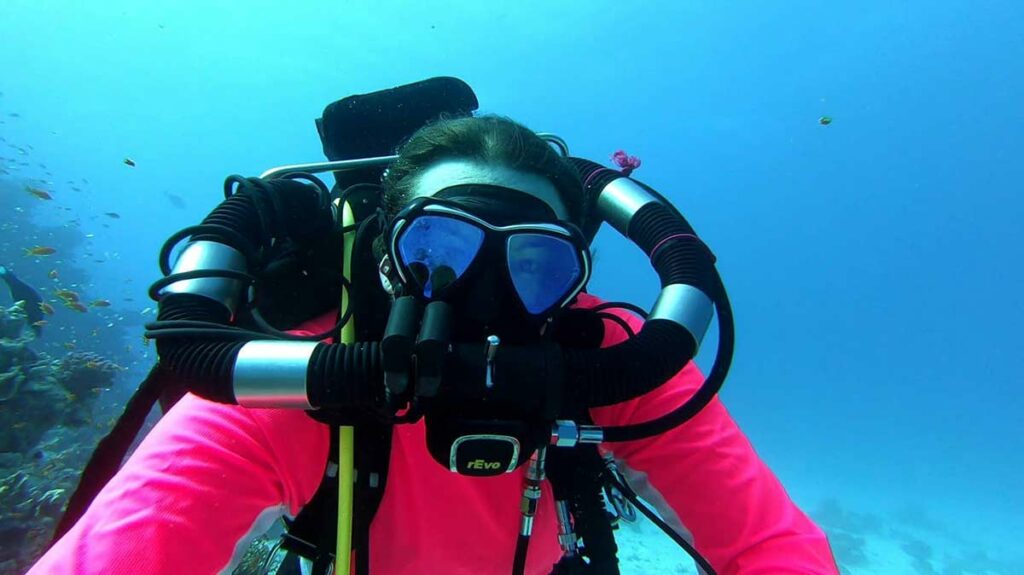
Conclusion
Rebreather diving is a game changer in the scuba diving world, providing divers with unmatched benefits such as longer dive times, closer animal encounters, and the sheer joy of a silent dive. It’s an experience that, once tried, frequently leaves divers wanting more. However, it is critical to recognize that these benefits come with a higher risk profile. Thorough training and certification are mandatory requirements. While rebreather diving is not for everyone, the destinations that do cater to this niche are nothing short of extraordinary. If you want to engage with the aquatic world on a deeper level, rebreather diving is for you – but only with caution and preparation.

